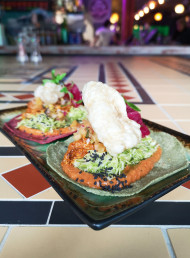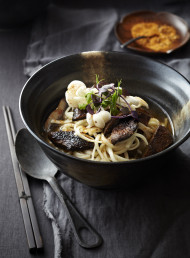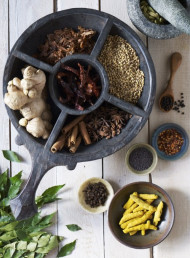Pantry essentials: Mexican
Photography by Aaron McLean.
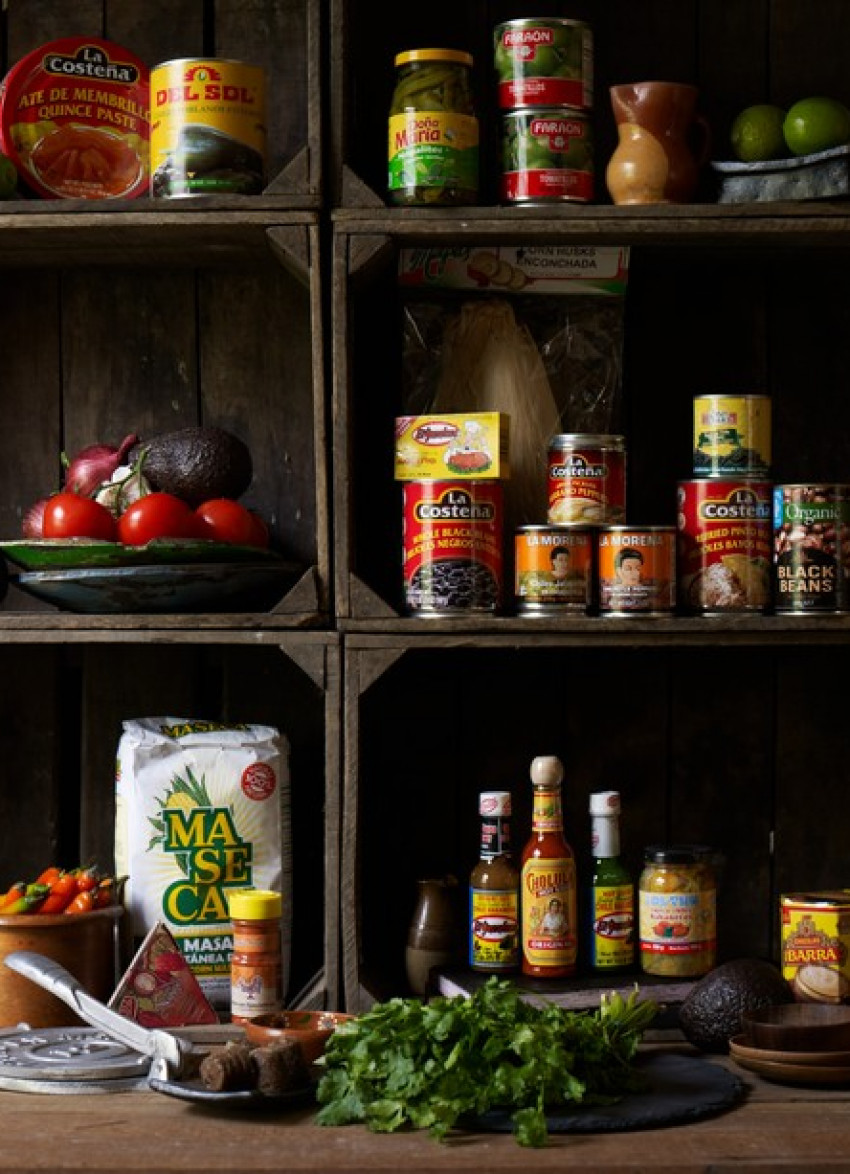
With a few pantry essentials you can recreate the tastes of Mexico whenever you want…
Mexican food has become increasingly popular over the last couple of years and is a far cry from the stodgy nachos and tacos to which Kiwis were previously accustomed. Access to authentic Mexican ingredients is easier for home cooks as well, with more gourmet food stores stocking products, and specialty online ordering also available. Here, we’ve given you a selection of key ingredients to keep on hand for your Mexican cooking.
FLOUR
Masa Harina: traditional Mexican flour made of maize, which is soaked in a lime-water solution. When softened, the corn is washed, ground into a paste, then dried and powdered. It is used to make tamales, tortillas and other dishes.
DRIED CHILLIES
Before using dried chillies, toast them lightly in a dry skillet over medium-high heat until lightly fragrant. This brings out their flavour and smokiness.
Anaheim: a mild chilli pepper with a fairly thick skin, Anaheim chillies are delicious both fresh and dried. The dried version is excellent for use in moles, stews or rubs.
Ancho: used mainly in moles (sauces), these are dried poblano peppers and are lightly acidic and fruity. Try them crushed and sprinkled lightly over grilled corn.
Chillies de arbol: retaining their bright red colour after being dried, chillies de arbol are one of the hotter varieties used in Mexican food and are used sparingly to increase heat. Cayenne pepper can be used as a substitute.
Chipotle: these are smoke-dried jalapeños, and add an earthy, smoky dimension to dishes. Because of their thick skins, they are best used in slow cooked sauces such as moles or braised meat dishes.
Guajillo: smooth and a reddish-brown colour, these chillies are one of the most used in the Mexican pantry and are relatively hot. Because of the leathery skin, guajillos should be well soaked before using. Commonly used in salsas, cooked sauces (moles) and stews.
Habanero: with a slightly fruity flavour, dried habaneros are a good way to brighten up any dish. One of the hottest chillies around, a pinch will go a long way.
Mulato: these are mild on the spice scale. One of the main ingredients in a cooked sauce (mole) and other slow cooked stews. When dried, the mulato chilli is sweet and earthy in flavour.
Pasilla: used in a wide range of dishes, pasillas are long, black and flavourful enough to spice up cooked sauces, guacamole or salsa. Mid-range on the heat scale.
Poblano: see Ancho chilli (when dried).
SPICES
Annatto seeds/achiote paste: achiote paste is made from garlic, annatto seeds and vinegar. Used to coat meats (mainly pork shoulder) before slow roasting, the acidity of the paste gives a nice balance to the fattiness of the meat. The annatto seeds are also a rich dye, so add a lovely red hue to dishes in which they’re used.
Allspice
Anise seeds
Cinnamon
Cloves
Coriander seeds
Cumin
Epazote: a herb grown in many parts of Mexico, epazote is pungent in flavour and often added to black bean recipes. It is also readily used in tamales, quesadillas and enchiladas in small quantities.
Peppercorns
Mexican oregano: completely different to Mediterranean oregano, the Mexican version has an earthy and slightly bold flavour. Used in stews or dishes that are cooked slowly for long periods of time.
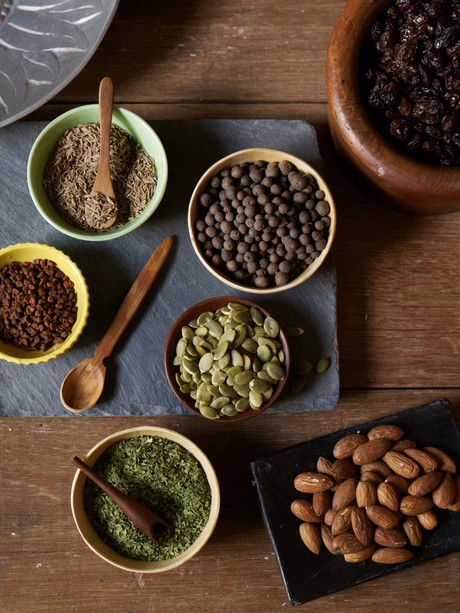
Clockwise from top left: cummin seeds, whole allspice, rasins, pumpkin seeds,
almonds, epazato, annatto seeds.
FRESH PRODUCE
Anaheim chillies: quickly roasted to remove the skin, these are also delicious stuffed.
Avocado
Coriander
Garlic
Habanero chillies: quite fruity and citrusy in flavour, habanero chillies are one of the hottest used in Mexican food. These round, thin-walled chillies are best pulverized and added in very small amounts.
Jalapeños: rich in flavour and moderately hot, fresh jalapeños are used liberally in salsas and guacamole. It is advisable to remove the seeds and dice finely to minimize the heat.
Limes: one of the staple ingredients in Mexican cooking. Used in most dishes and drinks (from fish tacos to margaritas), limes brighten up a dish while slightly mellowing the kick of any chillies.
Onions (yellow, red and white)
Plantains: similar in look to a banana, the plantain’s taste, however, is completely different. Low in sugar and high in starch, a plantain can be cooked for lengths of time without becoming mushy. Plantains
are so versatile they can move from a main course (fried in oil and served as a garnish) to dessert (baked with sweetened condensed milk) effortlessly.
Poblano chillies: sweet and mildly hot with tender skin and dense walls, poblanos are ideal for stuffing, such as in 'chile relleno' – a chilli stuffed with melted cheese, diced meat (often pork), covered in egg batter and fried.
Serrano chillies: a very hot, thin-walled chilli, the serrano is one of the most commonly used in the Mexican pantry. Spicy and fresh, it is best added in moderate portions to salsas, such as pico de gallo.
Tomatillos: similar in looks to a tomato, but encased in a paper-like cover, tomatillos are used broadly across the Mexican menu. With a slightly tart and fruity flavour, they can be used either fresh or charred, adding body to salsa verde, a staple Mexican salsa. Also available in tins at specialty stores.
Tomatoes (plum/Roma + standard)
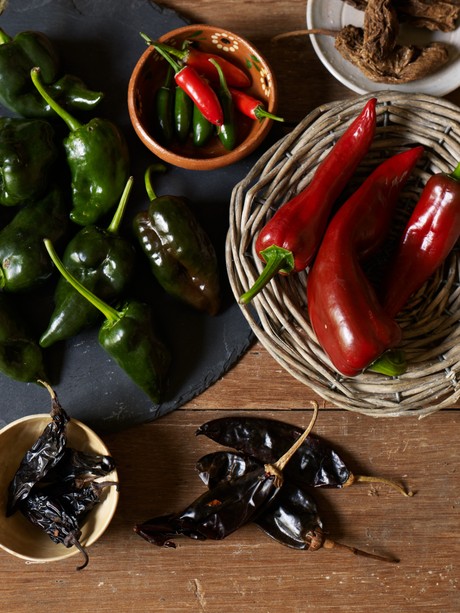
Clockwise from top centre: fresh serrano chillies (in bowl), dried chipotle peppers,
fresh Anaheim chillies, dried guajilo chillies, dried jalapeños, fresh poblano chillies.
BOTTLED/JARRED/PICKLED
Anaheim chillies: used for salsas, stuffed, or as a delicately spicy garnish. Mild and slightly sweet.
Chipotle peppers in adobo sauce: whole chipotles (smoked jalapeños) are combined with a sauce of tomato puree, paprika, sugar, salt, oregano, garlic, bay leaves and vinegar. The smokiness of the chipotles permeates the sauce and creates a delicious addition to slow cooked stews and enchilada sauce, as well as brightening up salsas.
Jalapeños: slightly lower in heat than the fresh version, jarred jalapeños are a superb alternative when fresh are unavailable. Best used in guacamole and salsas, this form of jalepeño should be a pantry staple.
Nopales: the thorny pad of the prickly pear cactus, nopales can be sliced thinly and used in salads, salsas and soups. The jarred variety has already been peeled to remove the spines. They have a crisp texture and a slightly bitter finish.
Poblano chillies: a good option when fresh poblanos are unavailable – preserved poblano chillies can be stuffed, used as a garnish or added to salsas for a mild kick.
Serrano chillies: used in the same capacity as fresh serrano chillies, these savoury peppers are very spicy and should be used sparingly.
Tomatillos: interchanged readily with fresh tomatillos, tinned tomatillos can be used to make salsa verde, enchilada sauce and anything else requiring a bright, tart flavour.
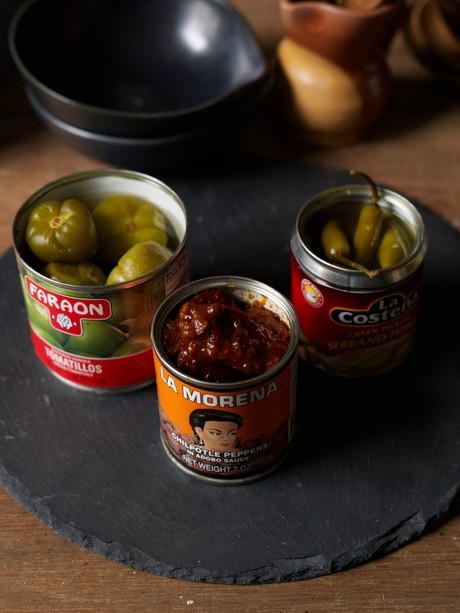
MISCELLANEOUS
Almonds
Black beans: high in fibre and protein, black beans are a staple in Mexican meals. Requiring pre-soaking for 2-8 hours, black beans are simple to make and are a delicious addition to stews and soups. Even a simple meal of steamed rice, black beans and a tablespoon of guacamole is extremely satisfying. They are also available in tins, cooked and ready to serve.
Chocolate Ibarra: packaged in a hexagonal yellow and red box, Chocolate Ibarra is Mexico’s answer to hot chocolate. A solid piece of cocoa, sugar and canella (cinnamon) is mixed with hot milk to create a delicious and exotic hot chocolate.
Cholula sauce: a staple in most Mexican homes, Cholula is a deliciously spicy blend of ingredients that adds a kick to just about anything. Made primarily with piquin peppers and chillies de arbol, only a few drops are necessary.
Corn husks: the dried outer husk of corn creates an envelope in which to make the famous and much-loved tamale. Stuffed with masa dough, meats and cheese, the corn husk is tightly wrapped around the filling, tied and then steamed. It imparts a wonderfully earthy flavour and aroma to the filling.
Jamaica (hibiscus): steep these dried flowers of the hibiscus plant in sugar or honey sweetened water and you will be rewarded with a refreshing, slightly tart drink. Known in Mexico as Agua de Jamaica, it is enjoyed not only in Mexico, but in many other parts of the world too.
Pinto beans: pale pink with light brown spots, pinto beans are cooked and eaten throughout Mexico. Soaked overnight then cooked slowly, pinto beans can be served whole or refried. Refried beans are soaked, boiled until soft and then cooked with lard and onions until the skins are soft and the texture is similar to mashed potatoes. They are also available in tins, cooked and ready to serve.
Pilconcillo: made from reduced sugar cane juice, this unrefined brown sugar is used in desserts or savoury dishes when sugar is called for. Often appears as small truncated cones of sugar.
Pumpkin seeds
Raisins
Rice (white)
Sesame seeds
DAIRY
Cotija cheese: a hard cows’ milk cheese. It is used mainly as a garnish, such as on Mexican corn or refried beans.
Lard: this rendered pig fat is often used in Mexican cooking to add flavour and creaminess to their staple dish of refried beans. It is also used in many other dishes to add a texture and flavour profile unlike any other form of oil.
Queso fresco: a fresh raw cows’ milk cheese made by acidifying the milk and allowing it to curdle. It is soft in texture and nicely complements both light and heavy dishes. You can substitute queso fresco with ricotta, goat’s cheese or feta.
Sour cream
EQUIPMENT
Molcajete (mortar and pestle): made from volcanic rock, the three-legged molcajete is used like a mortar and pestle. It is indispensable when making salsa and guacamole, along with grinding spice and herbs.
Tortilla press: virtually every meal in Mexico will somehow incorporate a tortilla, either corn or flour. Tortillas are easy to make, however rolling them can sometimes be a chore. The tortilla press is an easy and effective way to press the little pieces of dough to a consistent thickness each time. Most tortilla presses are two pieces of metal with a hinge connecting them. To use, place a piece of dough between two sheets of wax paper and place on the bottom piece of the press. Place the top piece of the press over the dough. Gently press the clamp over the top. Turn the dough around, as needed, and continue pressing and turning until the tortilla is the desired thickness.
Molinillo para chocolate: a traditional mixing stick made from a single piece of wood, with a textured knob at one end. To use, hold the top and roll between the palms of your hands. This whips air into the liquid and froths it up. For best results melt Chocolate Ibarra (see above) in hot milk and froth away.
Mexican pantry ingredients kindly supplied by Mexican Specialties. Phone 09 580 2497 or visit www.mexicanspecialities.co.nz
Fresh chillies kindly supplied by Orcona Chillis ‘n Peppers.
Phone 06 873 5083 or visit www.chilli.co.nz
latest issue:
Issue #120
As the days become shorter, and the nights cooler, the latest issue is perfectly timed to deliver delicious autumn dishes. From recipes using fresh seasonal produce such as feijoas and apples, to spectacular soothing soups and super-quick after-work meals in our Food Fast section, we’ve got you covered. With Easter on the horizon, we feature recipes that will see you through breakfast, lunch and dinner over a leisurely weekend holiday, and whip up chocolatey baking treats sure to please. We round up delicious dinners for two and showcase a hot new Korean cookbook before heading south to Dunedin to check out all that’s new in food and dining.The latest issue of dish is on sale NOW at all good bookstores and supermarkets – don’t miss it!

